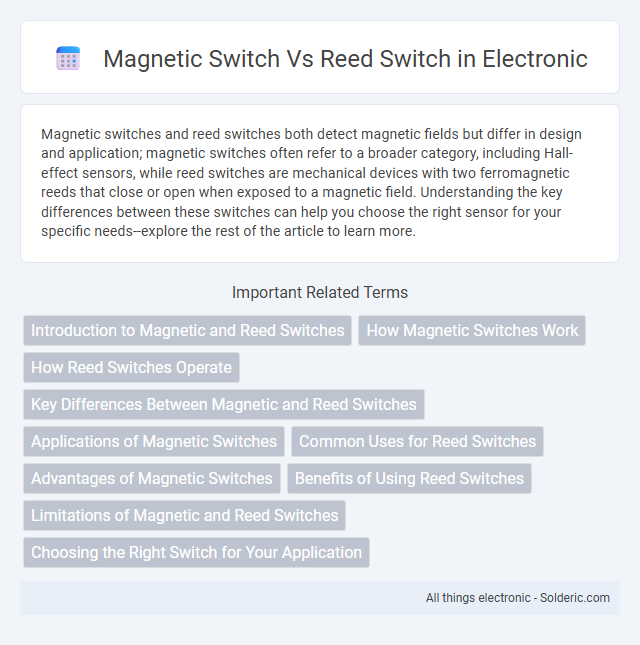Magnetic switches and reed switches both detect magnetic fields but differ in design and application; magnetic switches often refer to a broader category, including Hall-effect sensors, while reed switches are mechanical devices with two ferromagnetic reeds that close or open when exposed to a magnetic field. Understanding the key differences between these switches can help you choose the right sensor for your specific needs--explore the rest of the article to learn more.
Comparison Table
| Feature | Magnetic Switch | Reed Switch |
|---|---|---|
| Operating Principle | Detects magnetic field to open/close circuit | Contains ferromagnetic reeds that close when exposed to a magnetic field |
| Common Types | Hall effect sensors, magnetic proximity switches | Normally open or normally closed reed contacts |
| Sensing Range | Typically longer range (up to several cm) | Short range (a few millimeters) |
| Durability | Solid-state; high durability and longer lifespan | Mechanical contact; prone to wear over time |
| Switching Speed | Fast response (microseconds to milliseconds) | Moderate speed (milliseconds) |
| Applications | Position sensing, security systems, automotive sensors | Door/window sensors, flow meters, telephone switchboards |
| Power Consumption | Generally low (solid-state devices) | Negligible when idle; small current during contact closure |
| Electrical Contact | Typically solid-state output | Physical metal-to-metal contact |
Introduction to Magnetic and Reed Switches
Magnetic switches and reed switches operate based on magnetic fields to open or close electrical circuits, making them essential components in various sensing applications. A reed switch consists of two ferrous reeds sealed within a glass envelope that come together when exposed to a magnetic field, enabling contact closure. Magnetic switches encompass reed switches but also include other types like Hall effect sensors, providing diverse options for detecting magnetic presence with high reliability and sensitivity for Your projects.
How Magnetic Switches Work
Magnetic switches operate by using a magnetic field to open or close an electrical circuit without direct physical contact, often employing a coil and a movable armature inside the switch. When a magnetic field is present, it influences the armature to either complete or break the circuit, enabling reliable and contactless operation. These switches offer durable performance in harsh environments where mechanical wear and corrosion might affect traditional switch types.
How Reed Switches Operate
Reed switches operate by using two ferromagnetic blades sealed within a glass envelope that close or open an electrical circuit when exposed to a magnetic field. The magnetic field causes the blades to attract each other, completing the circuit without requiring any external power. This reliable, contact-based mechanism is widely used in security systems, proximity sensors, and various industrial applications.
Key Differences Between Magnetic and Reed Switches
Magnetic switches operate by detecting the presence or absence of a magnetic field to open or close an electrical circuit, whereas reed switches consist of two ferromagnetic reeds sealed in a glass envelope that physically contact each other when exposed to a magnetic field. Magnetic switches are often used in applications requiring non-contact sensing with a wide detection range, while reed switches provide precise, mechanical actuation with low current and voltage capabilities. Key differences include their operational principles, contact durability, and sensitivity to magnetic fields, affecting their suitability for various industrial, automotive, and security applications.
Applications of Magnetic Switches
Magnetic switches are widely used in security systems, industrial automation, and consumer electronics for detecting the presence or absence of magnetic fields. They reliably trigger alarms, control machinery, and enable proximity sensing in smart devices. Your choice of a magnetic switch can enhance system responsiveness and reduce maintenance needs in various applications.
Common Uses for Reed Switches
Reed switches are commonly used in security systems for door and window sensors, providing reliable open or close circuit signaling when a magnetic field is present. They are also prevalent in proximity sensing applications, such as in consumer electronics for detecting lid closure or in industrial machinery for position detection. Their low power consumption and inherent simplicity make reed switches ideal for automotive, medical devices, and HVAC system monitoring.
Advantages of Magnetic Switches
Magnetic switches offer enhanced durability and reliability compared to reed switches due to their solid-state design, which eliminates mechanical wear and tear. They provide faster response times and better sensitivity to magnetic fields, improving overall performance in security and automation systems. Your choice of magnetic switches ensures long-lasting operation and reduced maintenance in applications requiring consistent magnetic field detection.
Benefits of Using Reed Switches
Reed switches offer exceptional sensitivity and reliability in detecting magnetic fields, making them ideal for precise position sensing and security applications. Their hermetically sealed design provides durability and resistance to environmental factors such as dust, moisture, and vibration, enhancing longevity and reducing maintenance costs. Reed switches also consume minimal power and support fast switching speeds, optimizing efficiency in electronic circuits and automation systems.
Limitations of Magnetic and Reed Switches
Magnetic switches and reed switches both have limitations related to their sensitivity and environmental durability; magnetic switches can struggle with weak magnetic fields, reducing reliability in certain applications, while reed switches are prone to contact wear and can fail under high vibration or shock conditions. Both switch types often have limited switching speeds and current handling capabilities, making them unsuitable for high-frequency or high-power circuits. Understanding these constraints helps you select the appropriate switch to ensure optimal performance and longevity in your specific use case.
Choosing the Right Switch for Your Application
Magnetic switches and reed switches serve distinct purposes based on application requirements such as durability, sensitivity, and environmental conditions. Magnetic switches offer robust performance suited for high-vibration or harsh environments, while reed switches excel in low-power, precise detection tasks with minimal contact wear. Understanding your specific operational needs ensures selecting the ideal switch to maximize reliability and efficiency in your system.
magnetic switch vs reed switch Infographic

 solderic.com
solderic.com